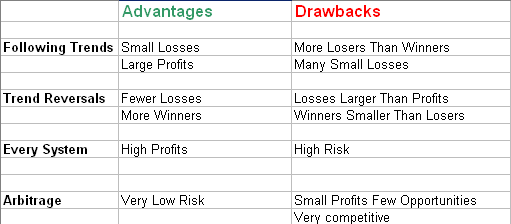Kryptonite
One of the most challenging questions asked during many job interviews is, "what are some of your weaknesses?" Some job candidates answer, "I have none." But let's face it, we all have weaknesses. In fact, "I have none" is a lousy answer. It shows that the candidate does not evaluate himself often enough. He appears to be unaware of his mistakes. The only people who don't make mistakes are those who don't risk a thing (perhaps that's the biggest mistake of all). This article is titled Kryptonite because we are going to discuss the strengths and weaknesses of various systems. Is there such thing as a system that takes no losses? There isn't, unless you're talking about a system that only trades once a year, once a decade, or perhaps once a century. Such systems are useless. There is no perfect system, but some systems are better than others. Stick to the good ones.
Trade Offs
Two prevalent systems that we will discuss are trend following and counter trending. Trend following is exactly what is sounds like- entering short trades after the stock has already fell for a while, while counter trending would sell short when the stock has begun a more recent decent following an upswing. The systems act the same for long trades as well. For instance stochastics is an indicator that uses counter-trending while, the momentum indicator is typically used for trend-following. Some of the strengths and weaknesses of both types of systems are shown below:

In the emotional game of trading, it is monumentally important to understand advantages and drawbacks of various systems. The reason trend following tends to have smaller losses is that traders following trends usually exit their positions soon if there is no confirmation of their initial suspicions. Thus, they are wrong more often than they are right, but when they are right, winning trades tend to be larger than losing trades. Trend reversals typically show the opposite results. These traders usually allow for more risk as a trade-off for more frequent wins. The inherent weakness is that losing trades tend to be larger than winning trades even though the losers are less frequent.
Both systems and virtually all trading systems can be tested and quantified using software such as Tradestation or Trade Navigator. These programs will test a systems and spit out results for the system over a given time period for a given security (or securities) including:
- percentage of trades profitable
- size of average winner compared to size of average loser
- percentage in the market
Software should be used whenever possible to save time. Knowledge of weaknesses is critical.
The Perfect System
Many traders have visions in their heads of perfect systems that will lead them inevitably to the pot of gold at the end of the rainbow. Such a system is quite elusive. However, it's a sure thing that some systems are better than others and thus there is such a thing as extremely good and extremely bad systems.
Here is what you need to be wary of when searching for an outstanding system. When you push in one place, you are likely pulling in another. For example, when you want winners to be bigger than losers, then losers will come more often than winners. If you want smaller losses, you will have them more frequently. Virtually every system is subject to these phenomena. The key is be like the strong job interviewer who knows his weaknesses and does not carelessly ignore them. Be disciplined- and trade well!
Price Headley is the founder and chief analyst of BigTrends.com.